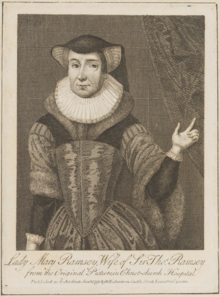Mary Ramsey (philanthropist)

Lady Mary Ramsey (née Dale; also known as Mary Avery; died 1601) was an English philanthropist. She married the Lord Mayor of London Thomas Ramsey.
Biography[edit]
Mary Dale born to Bristol merchant and sheriff William Dale.[3] Little being known about her early life. She married the pensioner Thomas Avery, formally in the service of Thomas Cromwell, in 1554. Upon his death Mary would swiftly remarry to the Lord Mayor of London Thomas Ramsey, one of the wealthiest men in Elizabethan London.[2][4]
The couple would undertake a wide range of philanthropic works, in the end totalling some £14,318, mostly around London.[4][5] The most widely remembered of these projects were there endowments to Christ's Hospital in London and Queen Elizabeth's Hospital in Bristol, in 1583.[5] After Thomas' death in 1590 Mary would continue the charitable effort, conveying her manor at Colne Engaine to Christ's Hospital and supporting them by endowing a set of scholarships at the collage.[2][6] She also undertook a verity of other charitable including the foundation of Essex grammar schools, the parish aid in London, funding several City companies (including the borough of Bristol) and funds for the relief of wounded soldiers, debtors and destitute university students.[7]
Ramsey died in November of 1601 and was buried at Christ Church. Her will made several large charitable bequeathments.[3] In an epitaph written after her death she was described as, "A Lady rare, most vertuous, meeke, and milde".[8] Thomas Haywood would portray a fictionalised version of Mary and Thomas Ramsey in his 1605 history play If You Know Not Me, You Know Nobody, Part I.[3]
References[edit]
Notes[edit]
- ^ The original painting shows Ramsey's right hand on a book, possibly showing appreciation for reading, but coupled with the upwards pointing gesture made with her other hand the book may be a Prayer book and the image an expression of her piety. Which ever is the case, placed within a hospital that was devoted to educating orphans and destitute children, it can be read as showing her commitment to supporting learning.[1]
Citations[edit]
- ^ Tittler 2008, p. 43-44.
- ^ a b c Archer 2008.
- ^ a b c Archer 2007, pp. 178–179.
- ^ a b Archer 2007, p. 179.
- ^ a b Tittler 2008, p. 42.
- ^ Times 1927.
- ^ Tittler 2008, p. 43.
- ^ Bourman 1602, p. 1.
Bibliography[edit]
- Archer, Ian W. (2007). "The Charity of London Widows in the Later Sixteenth and Early Seventeenth Centuries". In Jones, Norman L.; Woolf, Daniel (eds.). Local Identities in Late Medieval and Early Modern England. London: Palgrave Macmillan. pp. 178–206. ISBN 9780230001237.
- Archer, Ian W. (24 May 2008). "Ramsey [née Dale; other married name Avery], Mary, Lady Ramsey". Oxford Dictionary of National Biography (online ed.). Oxford University Press. doi:10.1093/ref:odnb/95611. (Subscription or UK public library membership required.)
- Bourman, Nicholas (1602). An epitaph upon the decease of the worshipfull Lady Mary Ramsey. Fleet-lane: R. R. Retrieved 31 March 2022.
- Tittler, Robert (2008). "Thomas Heywood and the Portrayal of Female Benefactors in Post-Reformation England". Early Theatre. 11 (1): 33–52. ISSN 1206-9078.
- (From a Correspondent) (9 November 1927). "The City And Education". The Times. No. 44734. London. p. xviii.
